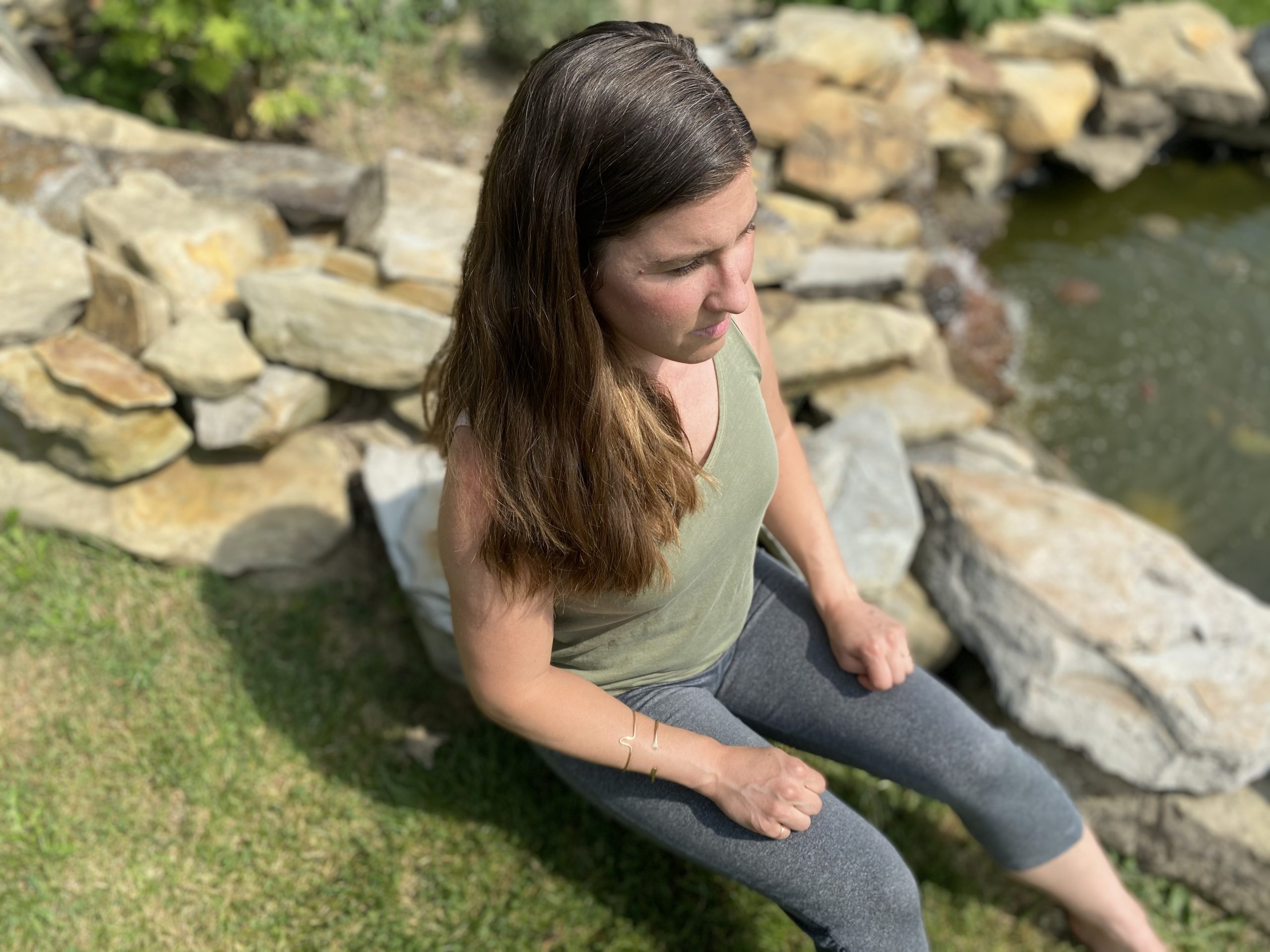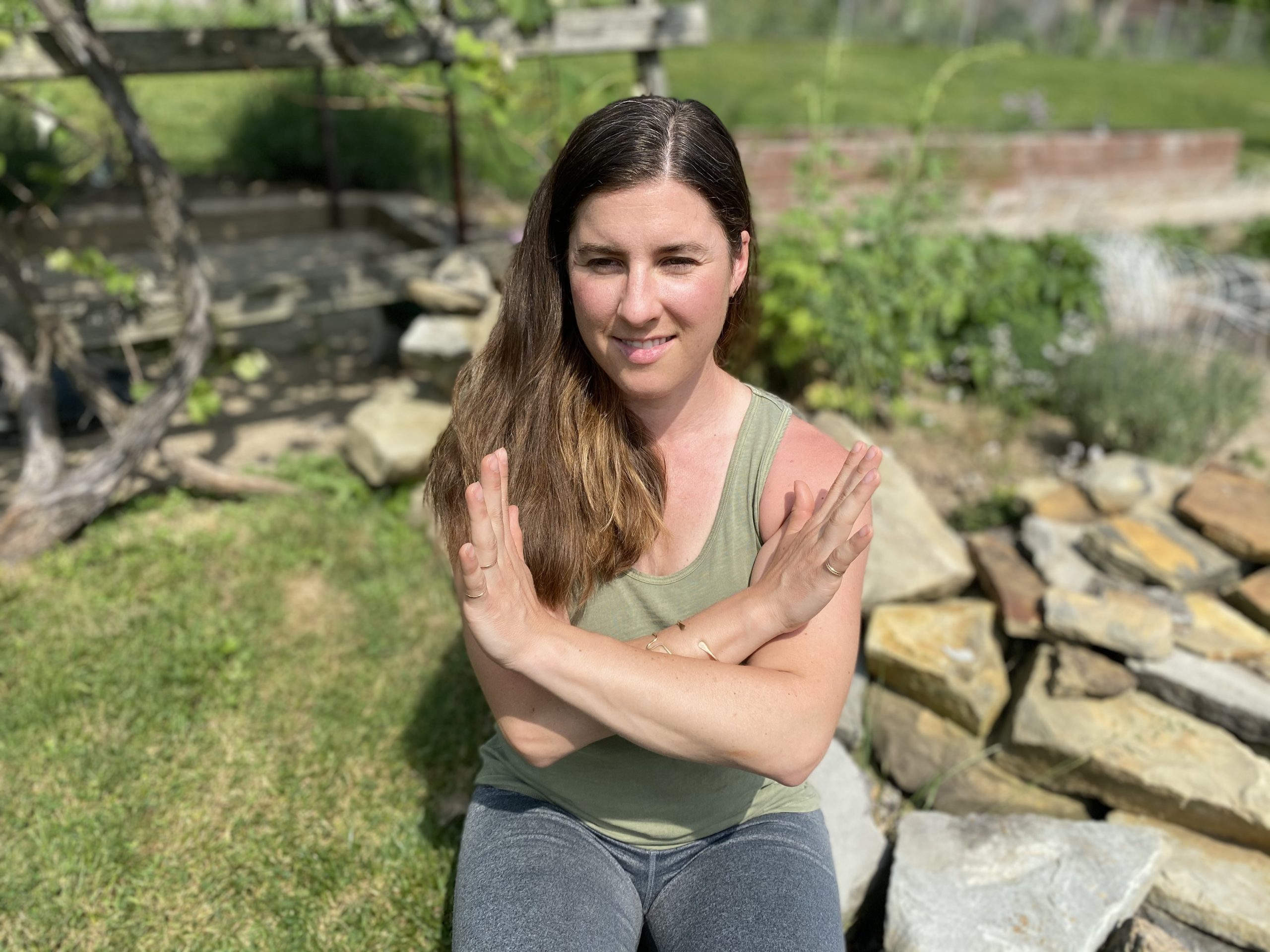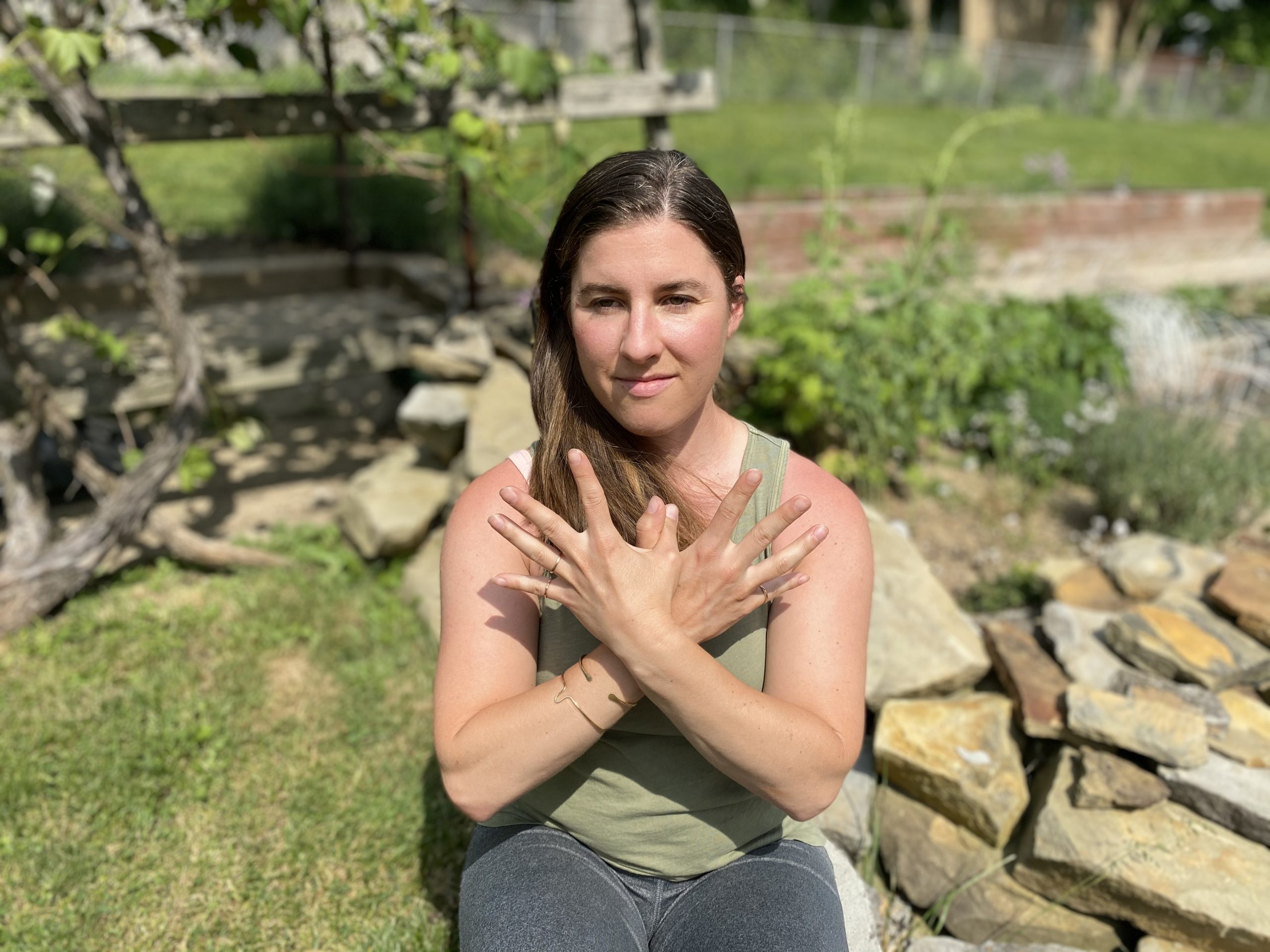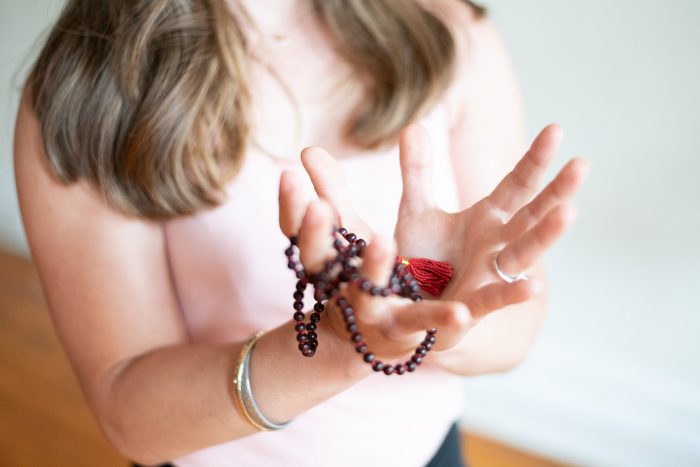*Elephant is not your doctor or hospital. Our lawyers would say “this website is not designed to, and should not be construed to provide medical advice, professional diagnosis, opinion, or treatment to you or any other individual, and is not intended as a substitute for medical or professional care and treatment. Always consult a health professional before trying out new home therapies or changing your diet.” But we can’t afford lawyers, and you knew all that. ~ Ed.
~
The tip of my right index (pointer) finger delicately touched the tip of my right thumb.
My left hand mirrored the same.
I sat cross-legged on a yoga blanket, learning from my first yoga teacher.
We practiced in a large, high-ceilinged room on a busy street, three stories up. It was a breathtaking and uncluttered space for yoga, owned by two architects turned yogis who lived in the neighborhood.
My teacher sat under the expansive wide windows so that 19-year-old me had a view of the marble gargoyles that sat atop the Iron and Glass Bank directly across the street. Beyond the bank was a blue-collar view of the South Side of Pittsburgh, Pennsylvania. The spacious and squeaky wooden floor gave us students plenty of room to spread out, so we did.
Each of my hands held the circular shape with the remaining three fingers outstretched.
“Jnana mudra, the mudra of all mudras…”
…I thought to myself as I recognized it in some faraway corner of my brain.
You’ve seen it before—that movie or commercial depicting monks in meditation, or hippies sitting cross-legged and singing Kumbaya around a campfire. Or maybe you’ve seen a dignified jade Buddha holding this gesture.
Mudra is a Sanskrit word that, at first glance, may seem foreign—but is likely something you’ve been practicing unconsciously your entire life.
Mudras are gestures taken with the hands (or body) that influence our physical, subtle (energetic), and emotional systems. There are mudras to help manage loss and stress, improve self-esteem, and to balance the chakras and other subtle systems.
Certain mudras can ease constipation, headaches, PMS, and a myriad of other health conditions. Mudras have been around the block. They are depicted in Buddhism, Christianity, Hinduism, and many other cultures. Prayer hands, arguably being the most recognizable mudra, places the palms together in front of the chest. We recognize this hand gesture as a sign of respect or devotion.
When you’ve experienced something touching or heartfelt, do you touch your hand to your heart? Maybe you make your hands into a fist when you’re angry or tense? What about throwing up your middle finger in condemnation? When we feel a certain way, we place our hands a certain way, though often unconscious.
Mudras show us that it works both ways. By taking a specific gesture with our hands, we have the potential to change how we feel. If, when we put our hand up to stop someone from entering our personal space, we are setting boundaries and strengthening our personal power, we can practice the same gesture in meditation as a way to develop healthy boundaries.
Mudras make the unconscious conscious; they are a bottom-up approach to health and wellness.
Try it out. Place your hands in hridaya mudra by taking your right hand over your heart and placing your left hand on top of your right. Take several slow deep breaths as you feel the connection of hands to heart. Feel it? A sense of relaxation, support, comfort? Maybe something else?
We tend to unconsciously place our hands in hridaya mudra when we experience empathy. Lucky for us, it works the other way as well. By placing the hands in this mudra, we can cultivate feelings of empathy, comfort, unconditional love, and support.
Mudras can even have an effect on our breathing, blood pressure, and energy level. Don’t get me wrong, mudras are not a substitute for medical care, but they are nonetheless powerful and an extremely accessible complement to a wellness plan.
I know, I know, it sounds too good to be true, like granting wishes with a wave of your hand. I agreed 100 percent until I immersed myself in the world of mudra, practicing them nearly daily over several months. For me. their effects didn’t show up all at once, but over time, I could tell my mudra practice was changing me.
When I first began studying mudras, I thought they were a pretty little anchor for my meditation practice. They didn’t “wow” me, but they certainly intrigued me—having been around for thousands of years and found within such a wide array of seemingly different cultures.
When I placed my hand in mudras, I felt playful and fancy. I continued to try them out because a teacher I valued and respected encouraged their practice, so I practiced. I read about mudras, learned a variety, and I practiced many gestures over the course of a few months. Because I retain information best when I teach, I taught mudras in my yoga classes.
For the first few weeks, I found learning and teaching different hand mudras to be intriguing and their practice a good way to improve the dexterity of my texting fingers. In nearly every group and private class I taught, I’d include at least one mudra, despite the nagging feeling that the majority of the students didn’t exactly seem to be buying what I was selling, although they placated me.
When I didn’t give up on the mudras after a few weeks, my students settled in. As they rode out my new fascination with hands, they began to expect mudras and miss them when they didn’t appear first thing in class. My students asked questions, requested recommended reading, and began practicing mudras on their own. Their curiosity sparked my interest even further.
There had to be something there, right?
It wasn’t until a couple of months in that I actually became a believer. At this point, I was still practicing and teaching mudras regularly. I felt a sense of peace and more than a little special with my new mudra knowledge anytime I practiced them. Don’t get me wrong, peaceful and special are great but I trusted the mudras held an even deeper secret. So, I kept digging.
My skeptical, “prove it to me” western mind was obstinate right up until it wasn’t anymore. Finally, one afternoon in the quiet of my petite yellow brick home in Pittsburgh, Pennsylvania, I felt it and I believed.
It started with a tingle, like a contained shiver that comes out of nowhere, but was persistent enough I knew I must be onto something. Was that prana, vital energy I wondered?
Then a few days later, at home again and after practicing matsya mudra (for healthy joints) during a late afternoon meditation session, I stood up and walked down the steep wooden stairs to my brightly lit dining room. As I picked up the ceramic mug filled with water, I realized the arthritic pain in my left (and most faithful) texting thumb had disappeared. It was just gone, evaporated into thin air sometime between when I sat down with matsya mudra and when I used my left hand to pick up the mug my nephew had made me in a ceramics class. Nothing else I had tried over the previous six months seemed to alleviate that ache. I was a believer.
Not long after I became a mudra believer, there was a mini avalanche of students expressing their fondness for the practices as well. “I can feel the energy,” they said. “A tingle,” “a swirling wind,” “a relief.”
Mudras eased my husband’s restless legs and fitful sleep, and now my students were incorporating them on anxiety-producing plane rides, at the dentist’s office, and after knitting or painting, which caused their hands to ache.
I took the mudras to the classes I taught on a mental health unit. I used them to encourage feelings of optimism and energy in those who were facing some of the most difficult times of their lives. I shared mudras for grounding with my students who struggled to sit still or fall asleep and mudras for personal strength when feelings of helplessness were present. In the unit, I used mudras to help my students develop body awareness, manage pain, develop focus and relaxation, and to encourage the nervous system into a state of balance.
Since the start of my mudra practice, I’ve used mudras to successfully release tension in my jaw, neck, and shoulders. Mudras have swiftly alleviated my sinus pressure at times and improved my breathing in addition to improving my sense of bodily and emotional awareness.
I still practice mudras daily, still curious to know more, and still feel more than a little special knowing what I already know.
There are many mudras to work with. I highly recommend further reading with Mudras for Healing and Transformation by Joseph Le Page and Lilian Aboim. Working with a yoga therapist to develop your mudra practice with an individualized approach can be extremely advantageous on a physical, mental, emotional, and spiritual level.
In the meantime, there are four mudras I find particularly suited to our current political climate, which necessitates a sense of poise, protection, communication, and love. Take several minutes (or more) holding each one. Breathe deeply and without moving on too quickly. Return back to the mudras that strike a chord with you, or continue practicing all four regularly.
Adhi Mudra for stillness, poise, and support
Make fists with your hands, thumbs on the inside with the four fingers enclosing them. Place your hands, palms down, on your body. Beneficial for cultivating a sense of stillness and grounding.
*This mudra can lower blood pressure so be sure to carefully monitor the effects.

Svasti Mudra for deflecting negative energy and creating healthy boundaries
Place your hands in a prayer position in front of your chest. Then cross your left arm in front of the right. The back of the hands will face each other, palms out.

Garuda Mudra for finding balance between rest and activity, releasing neck and jaw tension, and supporting clear communication
Hold your right palm toward (but not on) your chest. Place your left palm on the back of the right hand. Slide the hands out slightly wider to hook the thumbs together to form wings.

Hridaya Mudra for cultivating trust and love, and supporting a healthy immune system
Place your right hand over your heart. Place your left hand over the right.

There’s no good reason to ever force a mudra. If it doesn’t feel right, try something else instead. There are hundreds to choose from.
Take time to slow down and notice how you react to each on a physical, emotional, and spiritual level.
~
References:
Mudras for Healing and Transformation by Joseph Le Page, Lilia Le Page
“Effect of yoga hand mudra on cardiac and neurological parameters in preventing heart attack”







Read 13 comments and reply